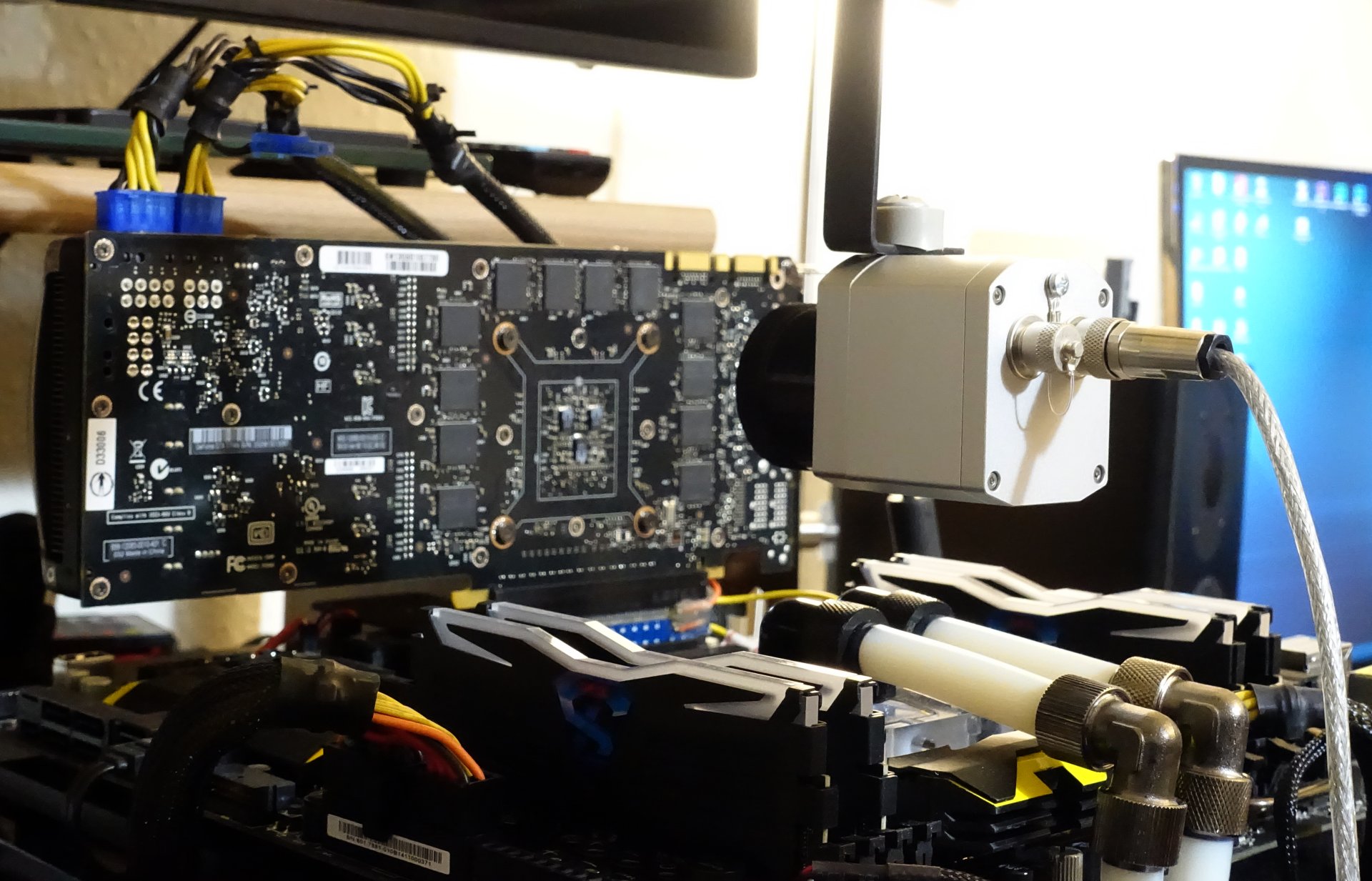Measurement Science: Taking Accurate IR Thermal Readings
If you thought that buying and unpacking an expensive infrared camera was all that it took to perform professional-level measurements, then it's time for a little lesson. We’ll share some of the knowledge that goes into generating accurate results.
Test System And Summary
The Right Base For Graphics Cards
We need an unobstructed view of the graphics cards, and nothing can be allowed to radiate heat in its direction. This is why we're using a full-blown water cooling solution with transparent tubing for the CPU, as opposed to an all-in-one solution with black tubing or even an air cooler. Our CPU block is flat, and we're using 90-degree angled fittings.
The graphics cards are connected via a 4cm riser. This way, components on the motherboard like RAM and heat sinks don't obstruct the measurement area. As a result, we can get perpendicular to the PCB in question.
We use a tripod and boom so that we can securely hold the camera in one place for any configuration we might need. This setup allows us to guarantee comparable camera positions for all of our infrared temperature measurements.
| Test Method | Real-time infrared monitoring and recording |
|---|---|
| Test Equipment | 1 x Optris PI640 80Hz infrared camera + PI Connect |
| Test System | Intel Core i7-5930K at 4.2GHz, water-cooledCrucial Ballistix Sport, 4x 4GB DDR4-2400MSI X99S XPower AC1x Crucial MX200, 500GB SSD (System)1x Corsair Force LS 960GB SSD (Applications, Data)be quiet Dark Power Pro, 850W PSUWindows 10 Pro (All Updates) |
| Water Cooling | Alphacool VPP655 Pump (voltage lowered)Alphacool NexXxos CPU coolerPhobya BalancerAlphacool 24cm radiator2x 12cm Noiseblocker eLoop fan at 400 RPM |
Summary
Infrared temperature measurement can be enlightening, answering questions that might have otherwise gone unaddressed. Unfortunately, there's a downside: the technology is expensive if it's done right.
Setting out on this path doesn't just involve studying the related material, but it also necessitates attending classes and workshops, and then applying the lessons learned there. The only alternative is recruiting someone familiar with these techniques due to their profession, of course.
Most measurements turn into educated guesses without important components like the lacquer with known emissivity to cover surfaces with unknown emissivity or professional tape. If these foundations aren't in place, then the results just won't be valid.
Using IR thermometers found at the local hardware store, or using the default settings of expensive professional IR cameras, does a disservice to the person measuring the temperatures and those trusting their results. Doing this right takes time and effort. And now you know what we go through to present accurate numbers.
Get Tom's Hardware's best news and in-depth reviews, straight to your inbox.
MORE: Best Graphics CardsMORE: All Graphics Content
Igor Wallossek is a Senior Contributing Editor for Tom's Hardware Germany, coveringCPUs and Graphics. Connect with Igor on Facebook.

Igor Wallossek wrote a wide variety of hardware articles for Tom's Hardware, with a strong focus on technical analysis and in-depth reviews. His contributions have spanned a broad spectrum of PC components, including GPUs, CPUs, workstations, and PC builds. His insightful articles provide readers with detailed knowledge to make informed decisions in the ever-evolving tech landscape
-
samopa Do they have some kind of API, to be connected to other system without using their proprietary software ?Reply -
dmnwlv Respect to tomshardware in its quest here to form a more complete picture in hardware tests and for presenting verifiable (factual) data in its reviews.Reply
I never bothered with all other sites' temperature charts/reviews on gpus ever since toms started doing this. -
FormatC Reply17594187 said:Do they have some kind of API, to be connected to other system without using their proprietary software ?
They have an API and a helpful documentation too. :)
-
Flying-Q I like all the isolation and standardisation you use for consistent, repeatable and accurate measurement. I have a question though: would a cowl over the CPU, chipset and memory make any difference to preventing reflected heat contribution from those components?Reply -
FormatC Only, if the waves goes in the same direction. Upgoing heat is no problem (90° crossing).Reply
I tried it to cover it with a thick, black foam plate - no difference. :) -
dr3cks4u Very good article, thanks for that. I´m sure a lot of people don´t know how time-consuming this kind of measurement is. Question @ Igor: Is the emissivity of the used lacquer constant across the electromagnetic spectrum (=grey body) or is it just known for the camera´s spectral range (7,5-13,0 microns)?Reply
